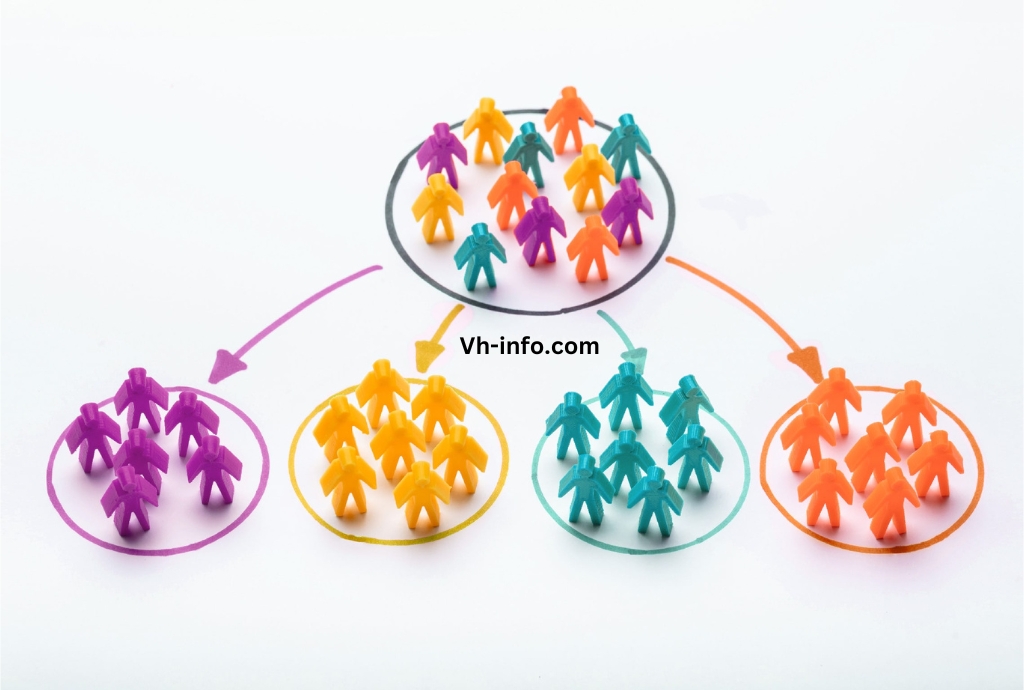Are you struggling to find a target audience for your marketing campaigns?
Market segmentation is the key to success! It is the process of dividing a larger market into smaller groups of consumers with similar needs or characteristics.
In this blog, you will learn what market segmentation is, why it’s important, and the different types of market segmentation. We’ll also explore other methods of market segmentation along with their objectives.
We will delve deeper into the strategies for market segmentation and how to determine your market segment.
Moreover, we will discuss the characteristics of good segmentation and the steps to implement it successfully.
Lastly, we will cover the benefits and limitations of market segmentation along with some examples and tips for proper market segmentation implementation.
Read on to learn how to reach your target audience effectively through market segmentation!
What Is Market Segmentation?

Market segmentation is like sorting people into groups based on similar traits or characteristics, such as age, income, interests, and location. It’s a smart way for businesses to understand their customers better and tailor their products and marketing to specific groups.
For example, if you know that one group prefers certain features in a product or responds to specific types of advertising, you can create more effective strategies. This helps companies connect with customers on a more personal level, making their messages more likely to hit the mark with their customer base.
Why is a Market Segmentation Strategy Important?
A market segmentation strategy is crucial because it helps you understand and connect with your specific target customers.
Imagine you’re selling a new type of dog food. With segmentation, you can identify groups of people who have dogs, then narrow it down further based on the dog’s breed.
This way, you can show tailored ads to each group for the dog food that suits their pet. Similarly, publishers can use this strategy to offer ads and content that resonate with specific audience segments.
By targeting the right people with the right message, you increase the chances of people engaging with your content or ads, making your marketing efforts more effective and delivering a better return on investment.
Types of Market Segmentation

Okay, so there are different ways to split up the market, and usually, one of them has two parts – one for regular people and one for businesses.
So, we end up with five common types of market segmentation.
Demographic Segmentation

Demographic segmentation is a basic way to understand customers. It means dividing the market based on things like age, income, gender, race, education, or job. The idea is that people with similar details have similar needs.
For instance, if you’re launching a new video game console, using demographic segmentation might show that most users are young guys with money to spend.
Firmographic Segmentation

Firmographic segmentation is like demographic segmentation but for companies. Instead of studying people, it checks out things about a business, like how many employees it has, how many customers, offices, or how much money it makes each year.
For instance, a company that sells software might offer a big, customizable package to a multinational corporation and a simpler, fixed-price one to smaller businesses.
Geographic Segmentation

Geographic segmentation is a bit like looking at where people live, and it’s part of studying details about them.
This way of dividing customers thinks that folks in the same area might want similar things. It’s handy for bigger companies wanting to open up in new places.
For example, a clothing store might show more rain jackets in their stores in the Pacific Northwest because it rains more there compared to their stores in the Southwest where it’s sunnier.
Behavioral Segmentation

Behavioral segmentation looks at a lot of info about what people do and how they make choices.
It puts customers into groups based on their past actions in markets. The idea is that if someone bought certain things before, they might do it again in the future, although things can change.
For instance, younger folks like millennials usually go for craft beer, while older generations often prefer national brands.
Psychographic Segmentation

Psychographic segmentation is a bit tricky but cool. It tries to group people based on how they live, their personality, what they think, and what they like. It’s a bit hard because these things can change easily, and we might not have clear facts about them.
But, it’s powerful because it puts people in groups based on what really drives them, not just what we can see.
For instance, a company selling workout clothes might go for folks who love playing or watching different sports.
Other Methods of Market Segmentation
- Value Segmentation: Certain companies might divide their customers based on how much money they’re likely to spend, which is called “transactional worth.” To figure this out, you can check past data, like how many times someone buys, how often they do it, and the value of the stuff they buy.
- Technographic Segmentation: Technographic segmentation is about putting people in groups based on the tech they use and how they use it. Like, you might want to aim at the folks who try out new gadgets first when you launch something new. Or, you could offer special deals to customers based on the device they use to shop online. For instance, showing Apple stuff to people who use Safari.
- Generational and Life Stage Segmentation: Generational segmentation is like breaking down customers by their age group – you know, like Boomers, Gen Z, Millennials, and so on. You can also group them based on things like whether they’re married, own a house, or have kids. For instance, Bank of America did this cool thing where they asked customers about their life stage when they signed up, and then they made a special website just for each group as part of their digital marketing strategy.
- Seasonal Segmentation: Just like we buy different stuff at different stages of our lives, we also buy different things during different times of the year. Big holidays like Christmas and Hanukkah really affect what we buy too.
Market Segmentation Objectives

Here are some key market segmentation objectives that businesses aim to achieve:
- Identify and target profitable customer groups – Market segmentation allows businesses to divide customers into groups based on certain characteristics like demographics, behaviors, needs, etc. The goal is to identify segments that represent opportunities for profitability. Businesses can then develop products, marketing and service strategies tailored specifically for those target segments.
- Increase sales and market share – By focusing product development and marketing efforts on well-defined customer segments, companies can better meet the needs of those customers. This can help boost sales and capture greater market share within the target segments.
- Retain existing customers – Segmentation helps businesses determine what current customers value the most. Companies can improve customer satisfaction and retention by ensuring they consistently deliver those desired benefits.
- Gain competitive advantage – A company can differentiate itself from competitors by tailoring its offerings toward a certain segment better than its rivals. The specialized products and marketing has the potential to resonate more with the target customers.
- Allocate resources efficiently – Businesses are able to prioritize and direct resources like R&D, sales and marketing budget to the customer segments that present the highest returns. This is a more focused and effective use of limited resources.
- Understand changing market needs – Segmentation provides insight into how different customer groups are evolving. Companies can identify emerging trends and changing needs within each segment and respond accordingly.
Strategies for Market Segmentation

A market segmentation strategy is like a plan to divide the people who might buy stuff into groups based on things like age, where they live, what they like, and how they act.
Businesses can do some steps to make a good strategy for this:
- Research the market: Before making a plan to split people into groups, it’s crucial to look into the various parts of the group you’re aiming for and find out what they like and what they want.
- Identify segmentation criteria: Businesses can decide what’s most important for dividing up their customers by looking at the market segment. It could be stuff like age, gender, how much money they make, and how educated they are. Or, it might include things like what kind of person they are, how they live, and what matters to them.
- Market Segmentation: Businesses can split the market into groups using the criteria they’ve figured out. It’s important to make sure that each group is clear, easy to measure, and actually helpful.
- Develop targeted marketing strategies: When businesses divide the market into groups, they can create special plans for each group. This might involve making products and services just for them, doing ads that specifically target them, and changing prices to fit what each group likes and wants.
- Evaluate how well the segmentation strategy worked: Businesses need to watch how well each group of customers is doing and make changes if needed to make sure the plan to split them into groups is working. This might include asking customers for their thoughts, checking how much stuff is being sold, and seeing how well ads are doing. A plan to divide customers into groups can help businesses understand their customers better, make special marketing plans, make customers happier, make better products, get more of the market, earn more money, and be more competitive.
How to Determine Your Market Segment?

Finding the right way to split up the market isn’t the same for everyone. Companies often ask themselves these questions during the process:
Phase I: Setting Expectations/Objectives
- Why are we doing market segmentation?
- What do we want to learn from it?
- Do we already have some ideas about the market segments?
Phase 2: Identify Customer Segments
- Who are our competitors selling to?
- What info from sources like the U.S. Census Bureau can help us?
- What data do we want, and how can we get it?
- Which of the five types of market segments do we want?
Phase 3: Evaluate Potential Segments
- What risks are there that our data isn’t really showing the true market?
- Why should we choose one type of customer over another?
- What happens in the long run if we pick one market segment over another?
- What’s our ideal customer, and which segments match them best?
Phase 4: Develop Segment Strategy
- How can we test our ideas in a small part of the market?
- What makes a market segment strategy successful?
- How can we tell if our strategy is working?
Phase 5: Launch and Monitor
- Who are the important people to get feedback from after we show our market split plan?
- What problems might come up, and how can we fix them?
- How do we tell everyone inside the company about our new marketing plan?
By answering these questions, companies can figure out the best way to split up their market and make their marketing plan work well.
Characteristics of Good Segmentation
When picking how to split up customers, it’s important to make sure the groups are meaningful, easy to reach, measurable, profitable, and simple to use.
Not all ways of splitting customers meet these needs the same way. Things like age and income are easier to measure than personality traits.
If you use multiple criteria to split customers, you often get a clear and measurable description of the group. On the other hand, using certain criteria can give a richer and more detailed description, but it might be harder to measure.
Steps to Implement a Market Segmentation

To use a plan for splitting up the market, you need to understand not just what market segmentation is, but also how to do it.
Here’s a simple guide:
Step 1: Figure out how big the market is and where your brand fits. Check if your products can really solve what they promise.
Step 2: Choose which type of market split suits your brand the best.
Step 3: Ask your customers the right questions based on the type you choose. You should know your target customer really well. Use online surveys to get their answers.
Step 4: After collecting responses, analyze the data to create special groups unique to your brand.
Step 5: Test if your plan is right by trying it out with your target customers. This helps you fix any issues with your market split plan.
Step 6: Once your marketing plans are tested and improved, use them on a bigger scale.
Step 7: See how well each group and marketing plan is doing, and make changes if needed.
Step 8: Keep making things better. It’s an ongoing process, so keep improving your market split plan and marketing strategies based on what customers say and how the market changes.
By doing these things, businesses can use a market segmentation plan well and have a better chance of doing well in the market.
Benefits of Market Segmentation
Understanding what market segmentation is and how it helps your organization is crucial for using it well.
Here are some of its benefits:
- Increased resource efficiency: Market segmentation helps managers concentrate on specific groups of people or customers. Instead of trying to sell things to everyone, it lets them focus more precisely, and this often costs less than trying to reach a huge audience.
- Find the ideal marketing strategies: Sometimes, it’s hard to figure out the best way to get the right people interested. This helps you understand your audience, make a plan that will work well, and find better ways to reach them.
- Stronger brand image: When using marketing segments, leaders need to think about how they want a particular group of people to see their company. After finding the right group, they must decide what message to create. Since this message is for a specific audience, the company’s branding and messaging become more intentional. This might also lead to better experiences for customers with the company.
- Stronger market differentiation: With market segmentation, a company can choose the exact message they want to tell the market and competitors. It also helps make their product stand out by showing exactly how they are different from others. Instead of a general marketing approach, leaders create a specific image that’s more likely to be remembered and unique.
- Design-targeted advertising: Market segmentation helps you aim your ads right at your audience in a successful and effective way. It’s like knowing their age, where they live, what they like to buy, and what interests them.
- Attract potential customers: When you send clear and straight-to-the-point marketing messages, you bring in the right people and have a better chance of turning them into customers.
- Greater potential for brand loyalty: Using marketing segmentation makes it more likely for people to form long-term connections with a company. When marketing is direct and personal, it can really connect with customers, making them feel included, part of a community, and like they belong. Plus, it boosts the chance of finding the right customers who fit well with your products and who you’re aiming for.
- Identify your niche market: It helps you find your special group of customers. Look for the group that has the most people and check if your brand can solve their needs well.
- Focus your efforts: This helps you find new chances to advertise and keeps you from getting sidetracked from your main audience.
- Create a customer connection: When you understand what your customers want, you can make smart plans. This helps build strong connections between your brand and the customer, making them really like your brand and be happy with it.
Limitations of Market Segmentation
Getting those advantages might also have some downsides to think about.
Here are some drawbacks to keep in mind when thinking about using market segmentation strategies.
- Increased costs: If you want to focus on certain groups of people, you might need more money for making special products, doing ads just for them, and managing a market segment.
- Increased product line complexity: Market segmentation tries to divide a big market into smaller parts. But be careful, it might make the product line too complicated, with too much focus on specific groups. Instead of having a clear product range, the company’s marketing might become confusing and not consistently show what the brand is about.
- Overlooking potential customers: If you pay too much attention to specific groups, you could overlook potential customers who don’t fit into those groups you’ve picked.
- Greater risk of misassumptions: Market segmentation assumes that people with similar details have similar needs. But, it might not always be true. When you group a bunch of people together thinking they are all the same, there’s a risk that you might not understand the different needs, values, or reasons within that group.
- Measuring effectiveness: It can be tough to figure out how well a split-up marketing plan is working because it’s not always clear which group is making a campaign successful or not.
- Higher reliance on reliable data: The strength of market segmentation depends on the info supporting it. It’s important to be careful about where the data comes from. Also, keep an eye on changing trends, and notice if the groups in the market have changed since the last study.
- Risk of stereotyping: There’s a danger of putting labels on certain groups based on things like age or personality, which might make people think negatively and react strongly.
Examples of Market Segmentation
Market segmentation is a smart strategy used by various businesses to understand and reach specific groups of customers effectively.
Take Victoria’s Secret, for instance, where they aim at women with their main brand and teenagers through PINK. Apple targets early adopters and wealthier customers, emphasizing their high-quality electronics.
In banking, Wells Fargo and JP Morgan Chase tailor their services based on the age and financial needs of customers. Grocery stores like Whole Foods focus on health-conscious consumers willing to pay more for organic products.
Even everyday items, like cars and cereal, show market segmentation. Auto manufacturers create products appealing to different groups, and cereal producers target various segments like older consumers and health-conscious individuals.
This strategy helps companies connect better with customers, making their products and marketing more effective.
Tips for Proper Market Segmentation

Here are some tips for properly segmenting a market:
- Focus on customer needs and values, not just demographics. Demographic factors like age and gender are limited. Look at psychographics and what benefits customers are really seeking.
- Ensure segments are measurable. There must be data available to quantify the company size, focus groups, audience segmentation, purchasing power and other attributes of each segment.
- Test segmentation hypotheses before fully committing. Do small-scale product or ad tests targeted at potential segments to confirm if they respond as expected.
- Choose segmentation variables that reflect business objectives. The variables you select to define the segments should help achieve goals like increased sales or market share.
- Segments should be substantial and profitable. Evaluate if potential segments are large enough and have sufficient growth potential to pursue.
- Segment buyers, not the general population. Focus on distinguishing customers with an interest or need from non-customers instead of the entire market. You can categorize markets based on factors like age, zip code, geographic location, social status, education, household income, marital status, family size, race, gender, occupation, and nationality.
- Avoid over-segmentation. Having too many narrow segments dilutes resources. Aim for distinct yet identifiable segments. Population density is a critical variable for segmentation strategies in marketing. It helps identify consumers based on their area characteristics (urban, suburban, rural) to avoid being too narrow.
- Regularly review segments for continued relevance. Customer needs shift over time so revisit the main types of market segmentation to ensure it aligns with market changes.
- Integrate segmentation in all marketing activities. Consistently develop tailored strategies across product, pricing, distribution and communication channels per segment.
- Protect segments from competitors. Use patents, trademarks, or other intellectual property to prevent competitors from easily copying your customer segmentation approaches.
Following these tips will help companies conduct segmentation analysis that provides actionable insights into customer’s unique needs and guides effective marketing strategies.
Leverage Segmentation Strategies to Create Targeted Marketing That Resonates with Niche Audiences
Segmentation strategies allow marketers to divide consumers into groups based on shared characteristics like demographics, behaviors, and psychographics. This helps create targeted messaging and positioning like focused differentiation.
There are various types of positioning, including functionality, user status, usage, and quality that should align to segmentation. Marketing positioning also requires understanding the customer journey to map TOFU vs BOFU audiences.
For financial services, psychographic segmentation works well to categorize audience mindsets.
The 5 Ps of marketing – product, price, place, promotion, and people should all be tailored to chosen segments. Paid acquisition enables reaching specific audiences.
Effective segmentation relies on qualitative research to uncover consumer insights for developing accurate profiles. Keyword outlines further help shape messaging by segment.
Overall, strategic segmentation is key for brands to connect with niche audiences rather than diluting efforts through mass marketing.
Conclusion
In conclusion, market segmentation is a crucial aspect of any successful marketing strategy.
By dividing your target market into distinct segments based on specific criteria, you can tailor your marketing efforts to better meet the needs and preferences of each segment.
This not only allows you to reach the right audience with the right message but also helps you allocate your resources more efficiently.
By conducting thorough market research, identifying key segmentation criteria, and developing targeted marketing strategies, you can effectively implement a market segmentation strategy.
However, it’s important to keep in mind that market segmentation has its limitations and requires ongoing evaluation to ensure its effectiveness.
By following these tips and best practices, you can maximize the benefits of market segmentation and drive the success of your marketing campaigns.

